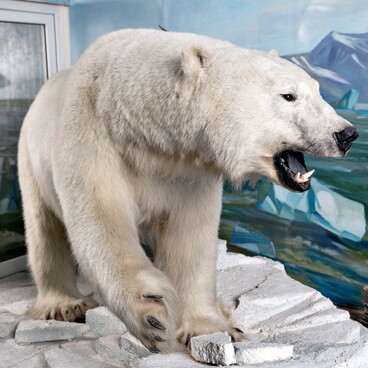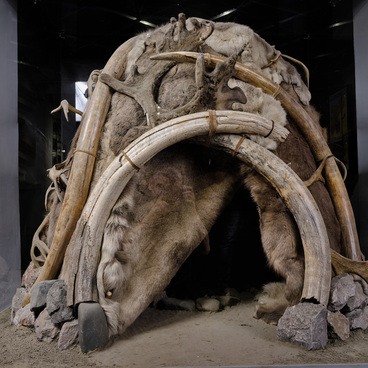The musk ox is a species of megafauna from the Pleistocene epoch, which is more than 60 per cent extinct. The musk oxen were part of the “mammoth fauna” (Ice Age megafauna), large animal species in the steppe-tundra zones of the last ice age. Apart from the wooly mammoth, the biocenosis included the Irish elk, the wild horse, the camel, the elk, the onager, the wooly rhinoceros, the cave lion, the bear, the wolf, rodents, the yak, and the European bison.
The majority of these species became extinct about 12,000 years ago. Of the ungulate mammals, only reindeer, bison and musk oxen have survived. There are two reasons for the mass extinction of animals around the world: global climate change and the settlement of Homo sapiens across continents. It is remarkable that among the extinct animals there are several species of hominids — Neanderthal, Australopithecus and Homo habilis.
The musk ox is a herbivorous animal with a short, stocky body covered with thick, dark wool. Its head resembles the one of a sheep and its body is like the one of a bull, hence the animal’s name in Latin — Ovibos. The musk ox has very long wool, in some places it can be as long as one meter. The musk oxen are strong and mighty animals, weighing up to 300 kilograms.
During the Ice Age, the musk ox lived on the vast plains of Eurasia and North America, feeding on stunted plants, lichens and mosses that it dug out of the snow. Ancient people actively hunted musk oxen: they ate their meat, sewed clothing of their skins, insulated houses with them, and used their horns to make tools. Later, musk oxen were used to transport heavy loads.
The musk ox managed to adapt to the new conditions,
and one of its subspecies still lives on the Earth — in particular, in the
north of the Krasnoyarsk Territory of Russia. These are imported animals: in
1975, 50 musk oxen from Canada and the USA were brought to the territory of
Taymyr. They started new herds, the likes of which lived on this land several
thousand years ago. These animals were acclimatized and are now actively
spreading across the peninsula. In the 2020s, the Taimyr population of musk
oxen is estimated at over 3,500 specimens.



